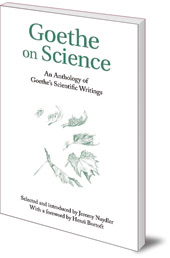Goethe on Science
An Anthology of Goethe's Scientific Writings
Quick Look
A systematic arrangement of extracts from Goethe's major scientific works which reveal how fundamentally different his approach was to scientific study of the natural world.
Description
Johann Wolfgang von Goethe is most famous for his work on colour theory, but he was also an accomplished all-round scientist, studying and writing on anatomy, geology, botany, zoology and meteorology. This book draws together, in Goethe's own words, his key ideas on nature, science and scientific method.
Goethe believed that we should study our world and nature as people at home in it, rather than removedly, as if we were aliens from another planet. He adopted a qualitative approach to science at odds with Newton's quantitative methods that were so popular in his day. His is a sensitive science which does not ignore our relationship to nature.
The extracts in this book are fascinating and essential reading for anyone who feels that we've lost our spiritual connection to nature.
Author
Jeremy Naydler is a philosopher and cultural historian who lives in Oxford. He is the author of Temple of the Cosmos: Ancient Egyptian Experience of the Sacred and The Reality That Is Not There: Reflections on Non-locational Space.
Henri Bortoft (1938-2012) was a physicist with an interest in the history of science and continental philosophy. He authored The Wholeness of Nature: Goethe's Way of Science (Floris Books, 1996, 2005) and Taking Appearance Seriously (Floris Books, 2012).
Links
Also by Jeremy Nadler:
Gardening as a Sacred Art
You may also enjoy other books on Goethe:
The Wholeness of Nature: Goethe's Way of Science by Henri Bortoft
Emerson and Science: Goethe, Monism and the Search for Unity by Peter Obuchowski
Goethe and Palladio: Goethe's study of the relationship between art and nature, leading through architecture to the discovery of the metamorphosis of plants by David Lowe and Simon Sharp
Readings in Goethean Science edited by Herbert H. Koepf

